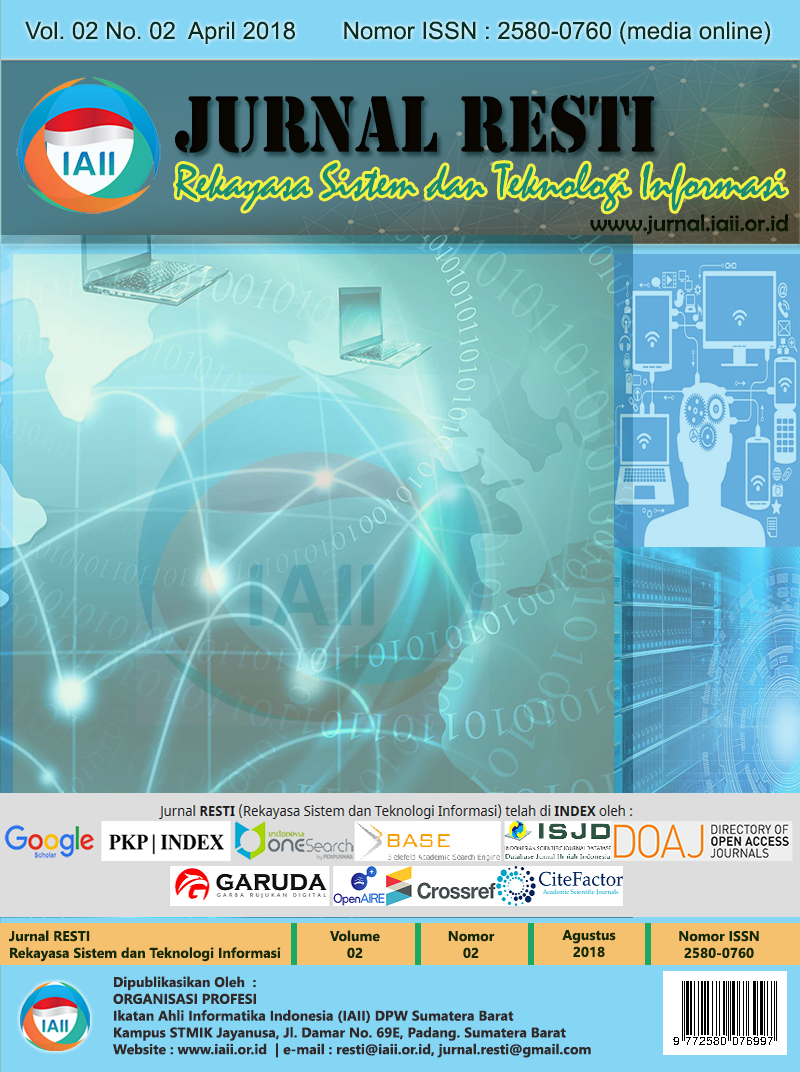Systematic Literature Review untuk Membuat Model Aplikasi Pemantauan Kesehatan Cardiovascular
Abstract
Human Computer Interaction (HCI) research and in particular usability aspects for cardiovascular disease (CVD) health monitoring application in the developing countries have been an underresearch phenomenon. In the era of digitization, heart patients are relying more on cardiovascular disease (CVD) health monitoring applications on mobile devices to monitor their hearts’ conditions. In order for the applications to be usable by the CVD patients, several usability aspects such as ease of use, learnability, effectiveness, flexibility and attitude of users are imperative in determining the usability of the applications. This research investigates the integration of usability aspects into CVD health monitoring application by usability engineers and system developers. This research employs Systematic Literature Review (SLR) method on usability aspects of CVD health monitoring applications. This research proposes a conceptual model called the Usability of Cardiovascular Health Monitoring Application Model (uCALM). The model aims to improve the usability aspects of CVD health monitoring application for the benefits of the patients and their cardiologists.
Downloads
References
[2] Anwar, F., 2017. 10 Penyebab Kematian Terbesar di Dunia. [Online]. Available: https://health.detik.com/berita- detikhealth/3416930/10-penyebab-kematian-terbesar-di-dunia-
1. [Accessed: 01-Dec-2017].
[3] Yusro, A. H., 2017. Penyakit Jantung Koroner di indonesia Penyebab Kematian Nomor 1 Manusia. [Online]. Available: http://www.sehatalamiyah.com/2017/05/mengenal-pembunuh- nomor-1-manusia.html. [Accessed: 13-Dec-2017].
[4] Surka, S., Edirippulige, S., Steyn, K., Gaziano, T., Puoane, T., and Levitt, N., 2014. Evaluating the use of mobile phone technology to enhance cardiovascular disease screening by
community health workers. Int. J. Med. Inform., vol. 83, no. 9,
pp. 648–654.
[5] Anshari, M., and Almunawar, M. N., 2016. Mobile Health ( mHealth ) Services and Online Health Educators. Biomed. Inform. Insights, pp. 19–28.
[6] Kumar, S., 2013. Mobile health technology evaluation: The mHealth evidence workshop. Am. J. Prev. Med., vol. 45, no. 2, pp. 228–236.
[7] Miller, A. S., Cafazzo, J. A., and Seto, E., 2016. A game plan: Gamification design principles in mHealth applications for chronic disease management. Health Informatics J., vol. 22, no. 2, pp. 184–193.
[8] Feinberg, L., Menon, J., Smith, R., Rajeev, J. G., Kumar, R.
K., and Banerjee, A., 2017. Potential for mobile health (mHealth) prevention of cardiovascular diseases in Kerala: A population-based survey. Indian Heart J., vol. 69, no. 2, pp.
182–199.
[9] Goldwater, J. C., 2016. Human Factors and Usability in Mobile Health Design – Factors for Sustained Patient Engagement in Diabetes Care. in International Symposium on Human Factors and Ergonomics in Health Care: Advancing the Cause, pp. 63–70.
[10] Logan, A. G.., 2007. Mobile Phone-Based Remote Patient
Monitoring System for Management of Hypertension in
Diabetic Patients. Am. J. Hypertens., vol. 20, no. 9, pp. 942–
948.
[11] Ariani, A., Koesoema, A. P., and Soegijoko, S. , 2017.
Innovative Healthcare Systems for the 21st Century. in Innovative Healthcare Systems for the 21st Century, Springer International Publishing AG 2017, pp. 15–70.
[12] Russ, A. L., Fairbanks, R. J., Karsh, B.-T., Militello, L. G., Saleem, J. J., and Wears, R. L., 2013. The science of human factors: separating fact from fiction, BMJ Qual. Saf., vol. 22, no. 10, pp. 802–808.
[13] Kurniawan, D. E., Saputra, A., and Prasetyawan, P., 2018. “Perancangan Sistem Terintegrasi pada Aplikasi Siklus Akuntansi dengan, Jurnal Rekayasa Sistem dan Teknologi
Informasi., vol. 2, no. 1, pp. 315–321.
[14] Kaufman, D. R.., 2003, Usability in the real world: Assessing medical information technologies in patients‟ homes, J. Biomed. Inform., vol. 36, no. 1–2, pp. 45–60.
[15] Gurses, A. P., 2012, Using human factors engineering to improve patient safety in the cardiovascular operating room, Work, vol. 41, no. SUPPL.1, pp. 1801–1804.
[16] Triantafyllidis, A., 2015, A personalised mobile-based home monitoring system for heart failure: The SUPPORT-HF Study, Int. J. Med. Inform., vol. 84, no. 10, pp. 743–753.
[17] Athilingam, P., Jenkins, B. A., Zumpano, H., and Labrador, M.
A., 2018, Mobile technology to improve heart failure outcomes: A proof of concept paper, Appl. Nurs. Res., vol. 39, no. September 2016, pp. 26–33.
[18] Neubeck, L., 2016, Development of an integrated e-health tool for people with, or at high risk of, cardiovascular disease: The Consumer Navigation of Electronic Cardiovascular Tools (CONNECT) web application, Int. J. Med. Inform., vol. 96, pp. 24–37.
[19] Boursalie, O., Samavi, R., and Doyle, T. E., 2015, M4CVD: Mobile machine learning model for monitoring cardiovascular disease, Procedia Comput. Sci., vol. 63, no. Icth, pp. 384–391.
[20] Li, B. N., Bin Fu, B., and Dong, M. C., 2008, Development of a mobile pulse waveform analyzer for cardiovascular health monitoring, Comput. Biol. Med., vol. 38, no. 4, pp. 438–445.
[21] Carver, J. C., Hassler, E., Hernandes, E., and Kraft, N. A.,
2013, Identifying Barriers to the Systematic Literature Review Process, in 2013 ACM / IEEE International Symposium on Empirical Software Engineering and Measurement, pp. 203–
212.
[22] Kitchenham, B., 2004, Procedures for performing systematic reviews, Keele, UK, Keele Univ., vol. 33, no. TR/SE-0401, p.
28.
[23] Levy, Y., and Ellis, T. J., 2006, A systems approach to conduct an effective literature review in support of information systems research, Informing Sci., vol. 9, pp. 181–211.
[24] Hamid, S., Bukhari, S., Ravana Azah, S. D., Norman, A., and Ijab, M. T., 2016, Role of Social Media in Information- Seeking Behaviour of International Students : A Systematic Literature Review, Aslib J. Inf. Manag., vol. 68, no. 5.
[25] Esfahani, M. D., Rahman, A. A., Zakaria, N. H., and Bahru, J.,
2015, Green IT / IS Adoption as Corporate Ecological Responsiveness : An Academic Literature Review, J. Soft Comput. Decis. Support Syst., vol. 2, no. 1, pp. 35–43.
[26] Abran, A., Khelifi, A., Suryn, W., and Seffah, A., 2003,
Usability meanings and interpretations in ISO standards,
Softw. Qual. J., vol. 11, no. 4, pp. 325–338.
[27] Davis, F. D., 1989, Perceived Usefulness , Perceived Ease of Use , and User Acceptance of lnformation Technology, MIS Q., vol. 13, no. 3, pp. 319–340.
[28] Davis, F. D., Bagozzi, R. P., and Warshaw, P. R., 1989, User
Acceptance of Computer Technology: A Comparison of Two
Jurnal RESTI (Rekayasa Sistem dan Teknologi Informasi) Vol. 2 No. 2 (2018) 458– 464
Theoretical Models, Manage. Sci., vol. 35, no. 8, pp. 982–
1003.
[29] Rogers, E. M., 1995, Diffusion of innovations.
[30] Furtado, E., De Fortaleza, U., Mattos, F. L., and Vanderdonckt, J., 2003, Improving Usability of an Online Learning System by Means of Multimedia, Collaboration and
Adaptation Resources, in Usability Evaluation of Online
Learning Programs, USA: INFORMATION SCIENCE PUBLISHING, pp. 68–85.
[31] Gluck, M., 1997, A Descriptive Study of the Usability of
Geospatial Metadata : OCLC Research, Annu. Rev. OCLC Res. [32] Ndubisi, N., 2006, Factors of Online Learning Adoption: A Comparative Juxtaposition of the Theory of Planned Behaviour and the Technology Acceptance Model, Int. J. E-
Learning, vol. 5, no. 4.
[33] Landauer, T. K., 1996. The Trouble with Computers: Usefulness, Usability, and Productivity. Cambridge: MIT Press.
[34] Booth, P. A., 1989, An Introduction to Human-computer
Interaction, New York: Pcychology Press.
[35] Hix, D., and Hartson, H. R., 1993, Developing user interfaces: Ensuring usability through product & process, 1st ed. Wiley.
[36] Nielsen, J., 1993, Usability Engineering. San Francisco: Morgan Kaufman.
[37] ISO, 1994, Ergonomic requirements for offi ce work with
visual display terminals. Part 11: Guidance on usability (ISO DIS 9241-11), ISO DIS 92. London: International Standards Organization.
[38] Jeng, J., 2005, Digital Libraries : Effectiveness , Effi ciency ,
Satisfaction , and Learnability, Assessment, vol. 55, pp. 96–
121.
[39] Clairmont, M., Dickstein, R., and Mills, V., 1998, Testing for Usability in the Design, in Conference proceedings from the Living the Future Conference.
[40] Blandford, B., 2004, Usability of Digital Libraries : Editorial,
J. Digit. Libr., vol. 4, no. 2, pp. 69–70.
[41] Brinck, T., Gergle, D., and Wood, S. D., 2001. Usability for the Web : Designing Web Sites that Work. San Francisco: Morgan Kaufman.
[42] Karoulis, A., and Pombortsis, 2003, Heuristic evaluation of
web-based ODL programs. Usability evaluation of online learning programs, in Usability evaluation of online learning programs, USA: INFORMATION SCIENCE PUBLISHING, pp. 88–109.
[43] Shackel, B. , 1986, Ergonomics in design for usability, in
People and Computers: Designing for Usability, pp. 44–64. [44] Shackel, B., 1991, Usability-Context, Framework, Definition,
Design and Evaluation. New York: Cambridge University
Press.
[45] Hammil, S. J., 2003, Usability Testing at Florida International University Libraries: What We Learned, Electron. J. Acad. Spescial Librariansh., vol. 1, no. 1.
[46] Augustine, S., and Greene, C., 2002, Discovering How Students Search a Library Web Site: A Usability Case Study, Coll. Res. Libr., vol. 63, no. 4, pp. 354–365.
[47] Lang, A. R., Martin, J. L., Sharples, S., and Crowe, J. A.,
2013, The effect of design on the usability and real world effectiveness of medical devices: A case study with adolescent users, Appl. Ergon., vol. 44, no. 5, pp. 799–810.
[48] Rubin, D., J., and Chisnell, 2008, Handbook of usability
testing [electronic resource] : How to plan, design, and conduct
effective tests, 2nd ed. Inidianapolis: Wiley Publishing.
[49] Benjes, C. and Brown, J. F., 2008, Test, Revise, Retest: Usability Testing and Library Web Sites, Internet Ref. Serv. Q., vol. 5, no. 4, pp. 10–12.
[50] Dumas, J. S., Redish, J., and Lewis, J. R., 1999. A practical
guide to usability testing.
[51] Vest, J. R., and Gamm, L. D., 2010, Health information exchange: Persistent challenges and new strategies, J. Am. Med. Informatics Assoc., vol. 17, no. 3, pp. 288–294.
[52] Fang, Y., Li, C., and Sun, L., 2016, Design of an Early Warning System for Patients with Cardiovascular Diseases under Mobile Environment, Procedia Comput. Sci., vol. 96, no. September, pp. 819–825.
[53] Lew, P., Zhang, L., and Wang, S., 2009, Model and Measurement for Web Application Usability from an End User Perspective, Proceeding QAW 1st Qual. Assess. Web Work.
held Int’l Congr. Web Eng. (ICWE ’09), CEUR Work.
Proceedings, vol. 561, no. 2007, p. 15.
[54] Ahmad, Zhang, and Azam, 2006, Measuring „Navigational Burden Publish, in the Fourth Int’l, Conf. on Software Engr. Research, Management and Applications.
Copyright (c) 2018 Jurnal RESTI (Rekayasa Sistem dan Teknologi Informasi)

This work is licensed under a Creative Commons Attribution 4.0 International License.
Copyright in each article belongs to the author
- The author acknowledges that the RESTI Journal (System Engineering and Information Technology) is the first publisher to publish with a license Creative Commons Attribution 4.0 International License.
- Authors can enter writing separately, arrange the non-exclusive distribution of manuscripts that have been published in this journal into other versions (eg sent to the author's institutional repository, publication in a book, etc.), by acknowledging that the manuscript has been published for the first time in the RESTI (Rekayasa Sistem dan Teknologi Informasi) journal ;







